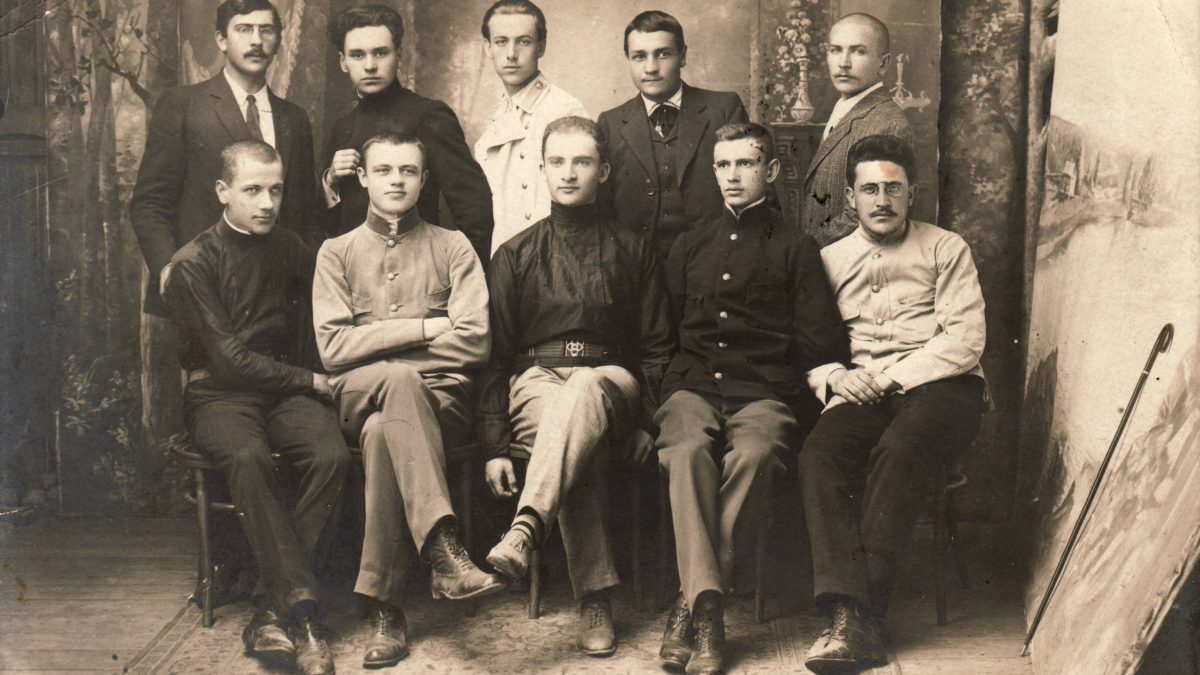Udell Family History In Chicago, Part 1

(Glenn Udell Maternal Grandfather, Jakob Kohan, Upper Row Left, photographed with fellow students in Russia)

(Jakob Kohan, grandfather of Glenn L. Udell, is listed on the March 24th, 1924 manifest of the SS George Washington.)
For years I have suggested to my wife that I was going to chronicle the history of my family, preserving a legacy for my sons while adding another, small chapter to the story of European Jews who came to Chicago in the early part of the 20th Century. With the turn of Winter into Spring, it seems an appropriate moment for me to transform these good intentions into a promise kept.
I am just off the trailing edge of the generation that can remember what it was like to sit in front of a monstrous micro-fiche reader, shuttling through reels of photographed documents and archived newspapers. While time consuming and inconvenient, scanning thousands of news stories, advertisements and headlines in a search for “Waldo” automatically provided a sense of the people, time and place.As those who share my nascent interest in genealogy know, researching your family’s past in the age of Google, Ancestry.com and the digitization of public documents can be an endless, all-consuming endeavor. The digital sources of information are so rich and deep that it’s easy to jump down rabbit holes, finding yourself hours later drowning in an asset-rich pool of data. With data on all sides you’re often shielded from a broader, contextual perspective that only traditional research can provide.
If your ancestors, like mine, were from Eastern Europe, the first step in any amateur sleuthing is to check the intake rolls of Ellis Island. During the first quarter of the twentieth century nearly three-fourths of all immigrants to the United States were processed through the Port of New York. The website, libertyellisfoundation.org, offers a free search for passengers by last name, estimated year of entry, date of birth and other variables. Within seconds, if you have an inkling of your family’s name, you’ll likely find the date of arrival and flag name for the ship. It’s empowering to get such immediate results!
Yet, how much does knowing a ship’s name and date of arrival tell you about the texture and tenor of the time? In the early 1900’s it was common for newspapers to herald the arrival of a vessel at Ellis Island, often describing the ship, notable passengers and frequently offering a list of travelers. My maternal grandfather, Jakob Kohan, traveled on the SS United States from Bremen Germany to Ellis Island in 1924, departing on March 24th and arriving April 4th. His voyage was likely listed incidentally in local German and New York newspapers.
Jewish Immigration toIn his short time at sea, those newspapers no doubt featured other timely stories, including collegian Johnny Weismuller setting an AAU swim meet record, Canada recognizing the USSR, and the sentencing in court of the upstart political figure, Adolf Hitler, to five years in prison for his part in the failed Beer Hall Putsch. There’s so many hidden assets shielded when using just a Google search, and I am excited to extend my research past the digital highway and onto the longer, more winding analog path.
Chicago – the First Wave
Much has been written about Jewish immigration to Chicago at the end of the nineteenth and beginning of the twentieth centuries. In addition to the standard fare of Wikipedia and other common sources of information, listed below are additional, helpful resources for amateur Chicago genealogists.
- The Jews of Chicago: From Shtetl to Suburb, Irving Cutler, 1996
- Chicago and its Jews, a Cultural History, Philip Pollack Bregstone, 1933
- The German-Jewish Migration to America, Max J. Kohler, 1901
- Spertus Institute for Jewish Learning & Leadership, Chicago, IL
- The Newberry Library, Chicago, IL
Most historians suggest that Jews, in small numbers, were to be found in Chicago well before it’s official founding in 1833. It’s likely that the earliest Jews to step foot in Chicago were Sephardic faithful from Spain and Portugal. This makes chronological sense, as Jewish explorers from these countries landed in North America as early as the late 1600’s, and founded Congregation Shearith Israel in 1654 in New York City.
The first permanent Jewish settlers in Chicago are generally believed to have arrived around 1841, with oral histories from the earliest German-Jewish
immigrants suggesting that a J. Gottlieb had preceded them in 1838. (He appears to be the Jewish version of Jean Baptiste Point du Sable. 🙂 ) While German attitudes towards Jews in the mid 1800’s had shown some liberalization, Jewish participation in the political and social lives of the German states was still limited. For example, a set of Bavarian laws, known as Matrikel, were implemented to restrict the number of Jewish marriages in a
given town or village. The result of these and other anti-Jewish laws was to stymie the growth of Jewish household, giving significant rise to the number of unmarried Jews.
Not surprisingly this, along with other slights both large and small, encouraged Jewish emigration to America, from 1840 to 1860. As was the case with most early waves of immigrants, men often preceded both women and children to a new life in Chicago. Once a livelihood was secured, the earliest émigrés would summon loved ones, friends and families to come join them in the frontier city by the Lake.

(Downtown Chicago circa 1840’s – Chicago History Museum)
Within just a few years, the Jewish community had grown from a handful to dozens in size. With growth came a natural diversity in the interpretation of spiritual law by the observant, spawning a divide of the Kehilath Anshe Ma’ariv faithful into a second congregation, Kehilath B’nai Sholom, that was formed by a group of twenty more conservative, orthodox Polish Jews.By 1845, Chicago celebrated the opening of its first synagogue, Kehilath Anshe Ma’ariv (alternatively Kehillat Anshe Ma’arab, which loosely translates into “Congregation of the Men of the West”). In what was not much more than a spare room above the Rosenfeld & Rosenberg dry goods building at 155 Lake Street, the ten to twenty, all-male congregants gathered in that year for Yom Kippur with Mayer Klein and Philip Newberg officiating as readers.
By 1859, less than 15 years after the first Day of Atonement service at Kehilath Anshe Ma’ariv, the observant community had established a Hebrew day school, created several societies for the interment of the deceased in a Jewish burial-ground, and created the United Hebrew Relief Association to tend to growing medical and social needs of incoming Jews from across Europe.
Movement of Chicago’s Earliest Jewish Community From the North to the South Side
As the Lake and Wells street address of Kehilath Anshe Ma’ariv suggests, the earliest Chicago Jewish immigrants settled into what would today be considered the City’s downtown. Their success, often as merchants and peddlers serving a growing population of fellow-immigrants, led to the accumulation of influence, property and wealth. By the time of the great fire of 1871, German-Jews had firmly established themselves in the Chicago community, serving in important private and public positions of leadership. For example, according to the article, Jews of Chicago, Kehilath Anshe Ma’ariv congregants Edward S. Solomon was elected Clerk of Cook County in 1861, and Jacob Rosenberg was elected to the Chicago City Council in 1876.
While the 1871 fire did not do great damage to the Jewish community or its real estate in the downtown area, the rebuilding provided the impetus for many of the newly successful German-Jews to move to the south side of Chicago and to establish new congregations and communities in Hyde Park, Kenwood and South Shore. The largely wooden, two story shops in which they worked and lived became more valuable as Chicago rebuilt and rapidly expanded geographically. One historian notes that the Fine Arts building, Auditorium, Congress, Blackstone and Stevens hotels were all built on parcels of land previously owned and occupied by Jewish merchants.
This southward movement of the earliest, prosperous Chicago Jewish pioneers was coincident with the second, larger wave of Jewish immigrants from Eastern Europe.
Causes of the Second, Eastern European Wave of Jews to Chicago
The period of 1880 through 1920 saw a massive acceleration of Jewish immigration through New York to Chicago. Upwards of 90% of the new immigrants came from the western lands controlled by the Russian Czars. Indeed, as Yannay Spitzer suggests in his book, Pogroms, Networks and Migration, “Over a single generation, more than a quarter of the Jewish-Russian population was settled overseas.”
My current reading suggests that historians are conflicted about the motivating factors behind the mass emigration of Jews during the period. Most of the older historical work suggests that the Pograms were the primary driver behind the mass exodus. Younger historians appear to believe that the dramatic shift from the agrarian to the industrial, coupled with constant political/religious discrimination, led to an economic deprivation that fueled the great Jewish migration.
First, let’s state the obvious. During the Pograms of 1881-1882 and 1903-1906 tens of thousands of Jews were killed or displaced by mob action that was either instigated, or tacitly approved, by the Russian government.
Russian laws had for centuries been antithetical to the Jews. The well-documented Pale of Settlement laws, created by Catherine the Great in 1791 and toughened by Czar Nicholas I, are the most obvious example. These rules, ebbing and flowing over time, restricted where most peasant Jews could live. These Jewish areas were known as the Pale of Settlement and were predominantly lands acquired by Russia as a result of the division of Poland in the late 1700’s.
My maternal grandfather, Jakob Kohan, was likely one of the more fortunate Jews who had a bit of freedom because Russian society needed his skills as a physician. Having had medical training and served in the Czar’s army, it is likely his life was better than the uneducated and unskilled Jews who endured in the rural shtetls. (More on Jakob Kohan’s story in a future blog post.)Yet even during enforcement of the Pale of Settlement if you were a Jewish merchant who could pay the First Guild registration fees, a university graduate, medical professional, artisan, or employed in a trade in short supply, you could live outside of the Pale of Settlement in urban “polite society.”
With little work for the unskilled of any religion or ethnic persuasion, tensions grew not only among Jews and non-Jews, but also within the Jewish community itself. It did not take much for those least likely to find life-sustaining work to choose emigration over starvation. The Pograms no doubt accelerated the exodus of Jews to the West, but empty bellies and starving hopes were likely the primary cause.The newer historic perspective of Jewish emigration is more tightly focused on the economic hardships that common Jews endured not only because of anti-Semitic bigotry, but also by the inevitable dislocations that resulted from the forced transformation of a backward, agrarian Russian economy in a rapidly industrializing world. Proponents of this perspective point to the privation suffered by all Russian peasants in the middle 1800’s.
It was in this context that my forbears, The Kohans and Udelevitzs from Russia, and the Taszs from Poland, boarded different ships, for different reasons and at different times for a journey to America. I look forward to sharing the next chapter of their story in a future blog post.
- Illinois Sports Betting: Are the Odds Rigged Against Poorer Communities? - November 13, 2019
- A Blessed Thanksgiving in 2018 - November 20, 2018
- It’s More Than Planting Trees: The Jewish National Fund – USA - October 27, 2018








